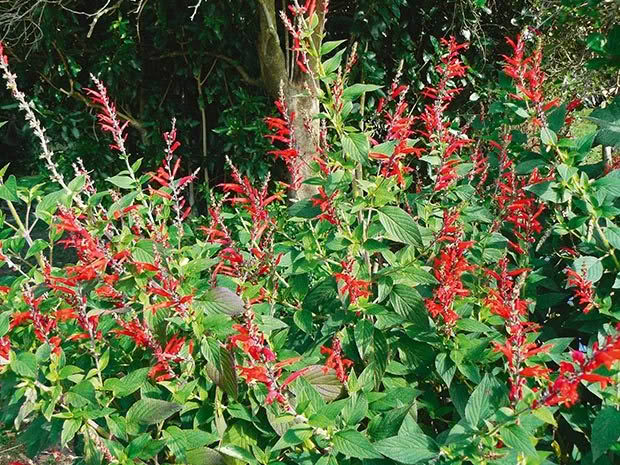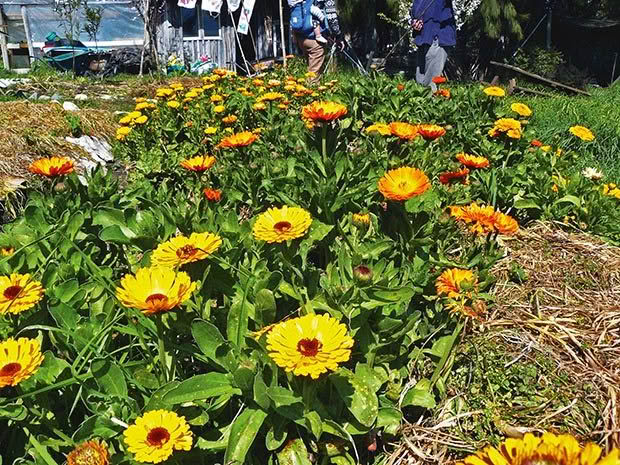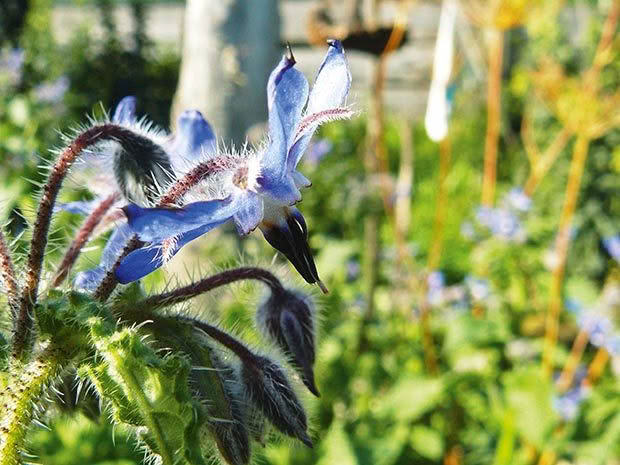11 ways to use edible flowers

A dish isn’t complete without a little petal power.
Words: Kristina Jensen
The very first flowers I remember sampling as a child were red clover. My brother and I didn’t so much eat them as sip them. We would spend hours pulling each delicate little tube out of the flower head in order to suck out the delicious smidgeon of nectar hiding there. Maybe our parents showed us this and maybe it was the bumblebees that gave us the clue, sharing right along with us as we sat in the long grass having our treat.
It wasn’t long before we had extended this method of extraction to honeysuckle, comfrey and pineapple sage. Every now and then, a whole flower would get sucked in and munched down, starting me off on a life-long journey of eating flowers.

Pineapple Sage.
I’m known for my salads out here in the Marlborough Sounds, which almost always include flowers. I love to grow masses of pick-a-leaf-as-you-go greens all year round like red coral mizuna, rocket, mibuna, miners lettuce, corn salad and land cress. But eventually, in the way of all things, the plants start to go to seed, and on the way they produce very tasty flowers which also end up in salads, in my trade-mark weed pesto, or as decoration on cakes.
FLOWER POWER
Flowers enhance any garden in my mind, and if you can also eat them, then all the better. They add such a beautiful, almost exotic flair to certain dishes, and despite their diminutive size have nutritional benefits to boot. Many flowers are high in vitamins C and A. Recent studies have revealed that certain flowers have antioxidant properties due to the high levels of phenols present, with calendula and Jerusalem artichoke two of the highest.

Calendula.
Flowers have been used throughout history for healing purposes, such as treating open wounds and in aromatherapy. We’re all familiar with the wonderful scents of roses and lavender, and I am always amazed at how the cares of the world just seem to vanish when I pop my nose into a fragrant rose bloom and inhale. But why just smell the roses? Why not eat them as well?
Borage (or ‘porridge’ flowers as one of my sons called them in his toddler stage) is great as a pick-me-up when I’m feeling low. Yep, I’m definitely a flower eater and seeing as there are over 50 different kinds of edible flowers, there’s always something new to sample.

Borage.
While I’m quite happy waxing lyrical about the sweet little faces of johnny jump ups (heartsease) or the spicy hit from a nasturtium blossom, I’d like to take the opportunity on the following pages to introduce you to two wild edible flowers growing here in New Zealand, along with two of my tried and true favourite recipes. Go forth and eat flowers!
MORE THAN MEETS THE TONGUE
Even my first favourite is more than a sweet treat. The use of red clover as an herbal remedy goes back centuries, where it was often a main ingredient in liniments and balms used for relieving eczema, psoriasis, sores and burns. The pain-relieving properties of red clover are likely due to the presence of the anti-inflammatory compounds, such as salicylic acid in the flowers (salicylic acid is the active ingredient of asprin). Red clover is also used as a blood purifier, and is a mainstay ingredient in many traditional herbal formulas for cancer.
SPECIAL NOTES ON EATING EDIBLE FLOWERS
• Make sure you can identify what you are eating – when in doubt, leave it out.
• Organic/no spray is always best.
• It is recommended you wash all flowers before eating them – if they are from my garden, I don’t bother because I know I haven’t used anything on them.
• Remove pistols and stamens from flowers before eating them.
• If you have allergies, introduce gradually to make sure you don’t have a reaction.
• Don’t eat flowers from florists.
• Don’t eat flowers picked from the side of the road.
11 WAYS TO USE EDIBLE FLOWERS
• Use the petals in or on biscuits or muffins.
• Use them for infusing oils and flavouring and colouring vinegars.
• Use flowers as decorations in punch or tea (borage flowers look great floating in gin!)
• Toss flowers into salads.
• Sprinkle flowers as a garnish onto bowls of chilled gazpacho or other cold soups.
• Blend flowers into butter, soft cheese or yoghurt.
• Add dried flower buds to sugar and salt for a whisper of flavour.
• Freeze petals or whole flowers in ice cubes and add them to your lemonade or punch.
• Roses used to line a cake pan impart a wonderful flavour to a cake.
• Nasturtium blooms can be stuffed with herbed cream cheese for excellent hors d’oeuvres.
• Pansies, violets and calendula make excellent cake decorations.
KRISTINA’S TIP TO TASTY FLOWERS
It’s best to pick flowers first thing in the morning after the dew has dried when they just are beginning to open. That way, you get peak flavour. You can keep them fresh by carefully folding them into a damp paper towel kept on a plate in the fridge.
READ MORE
Love this story? Subscribe now!
 This article first appeared in NZ Lifestyle Block Magazine.
This article first appeared in NZ Lifestyle Block Magazine.
